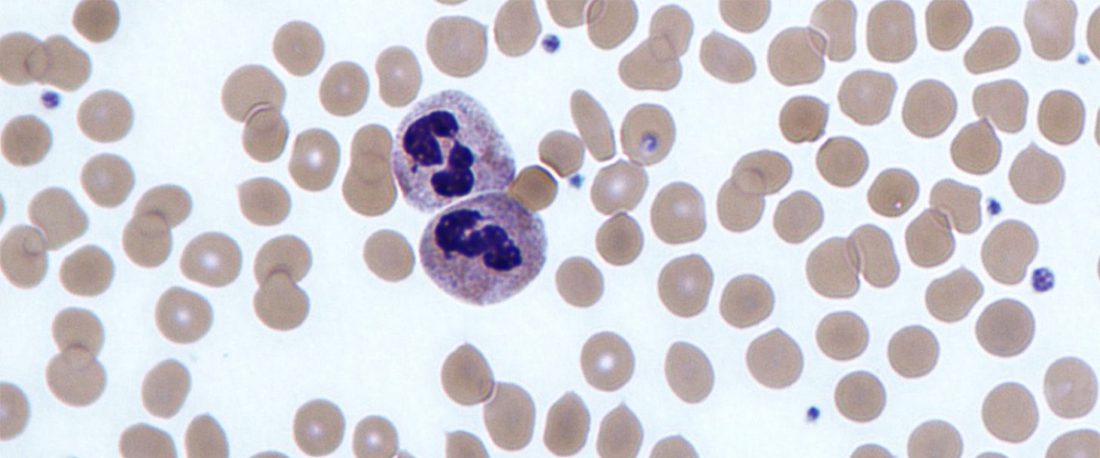Learn about different types of white blood cell, the range of things that can cause agranulocytosis, what the symptoms of agranulocytosis are, and view Trust guidelines on how to manage clozapine.
You’ll know that clozapine can cause agranulocytosis and neutropenia, but unless you work in a Clozapine Clinic, you may not know what these terms mean, what else can cause the condition, how it presents, or the finer details of its clinical management. Working through this post should help you build your knowledge and understanding of clozapine’s risks.
First, it may help to understand what granulocytes and neutrophils are. Granulocytes is an umbrella term for white blood cells that have (when chemically treated) visible granules in them. The picture at the top is a good example, where you can see four granulocytes in a sea of red blood cells. There are three different types of granulocyte: neutrophils, eosinophils and basophils. If you’d like to know more about these different types of granulocyte, this website gives a handy and informal description of all of them.
So agranulocytosis is a lack of granulocytes in general, and neutropenia is a lack of neutrophils specifically.
Have a look at this NHS Choices page on agranulocytosis and neutropenia, and answer the following questions:
- What diseases can cause agranulocytosis / neutropenia?
- What categories of medicine most commonly cause agranulocytosis / neutropenia?
- What are the symptoms of agranulocytosis / neutropenia?
As Lab Tests Online say, there is no straightforward target range for white blood cell count, as their abundance can vary depending on age, gender, sample population and test method. The sample population you’re likely to be interested in is those taking clozapine…
Every Trust should have a freely-available policy on clozapine management, the details of which may vary slightly. As I work within East London Foundation Trust, here is their Clozapine Policy as an example. It’s a lengthy document, so below are some questions to help you focus. You may want to see if you can answer these questions from your own trust’s policy.
- Pgs 8-9: These are pertinent to the clinical management of agranulocytosis / neutropenia.
- What is benign ethnic neutropenia?
- What is the required monitoring for agranulocytosis / neutropenia?
- What happens if people get a green, amber or red result?
- Pgs10-16: These cover other health risks of Clozapine use.
- What conditions does it cover?
- As a nurse, do you know how you would you manage these risks?
- Pg 35: Covers smoking cessation and nursing responsibilities.
- How does smoking affect the efficacy of clozapine?
- What are the dangers of smoking cessation with service users taking clozapine?
Further Academic Reading
For qualified NHS staff, see the Resources page for how to access these articles.
- Cohen, D. & Monden, M. 2013, “White Blood Cell Monitoring During Long-Term Clozapine Treatment”, American Journal of Psychiatry, vol. 170, no. 4, pp. 366-369.
- De Hert, M., De Beugher, A., Sweers, K., Wampers, M., Correll, C. & Cohen, D. 2016, “Knowledge of Psychiatric Nurses About the Potentially Lethal Side-Effects of Clozapine”, ARCHIVES OF PSYCHIATRIC NURSING, vol. 30, no. 1, pp. 79-83.
- Brosnan, S., Barron, E. & Sahm, L. 2012, “Health literacy and the Clozapine patient”, Perspectives in Public Health, vol. 132, no. 1, pp. 39-42.

